We often disregard skin cancer when comes to our dog’s health as they are covered with hair. But skin cancer is a highly sensitive matter in canines.
It is natural to feel worried if you notice a peculiar bump or lump on your dog’s skin. Most people might describe this as carcinogenic, or suppose your vet has already diagnosed the condition in your family pet; it is normal to feel worried.
The thought of learning that your pup has skin cancer is discouraging; however, the diagnosis may not be as awful as you imagine. Let’s learn about Dog Skin Cancer, its symptoms, and ways you can keep your furry friend from having this condition.
Can Dogs Get Skin Cancer?
The danger of skin cancer is enough to get anyone to use sunscreen or pay attention to strange pimples or lumps that could hint at a malignant form of cancer. However, humans aren’t the only beings who have to watch over their skin. Dogs can be inflicted with skin cancer, as well.
You might assume that your dog’s fur keeps them safe from skin cancer. Despite all that fur, they can still be defenseless against harmful UV rays, especially on parts of their body with little to no hairs. These include areas like the belly, snout, and paw pads.
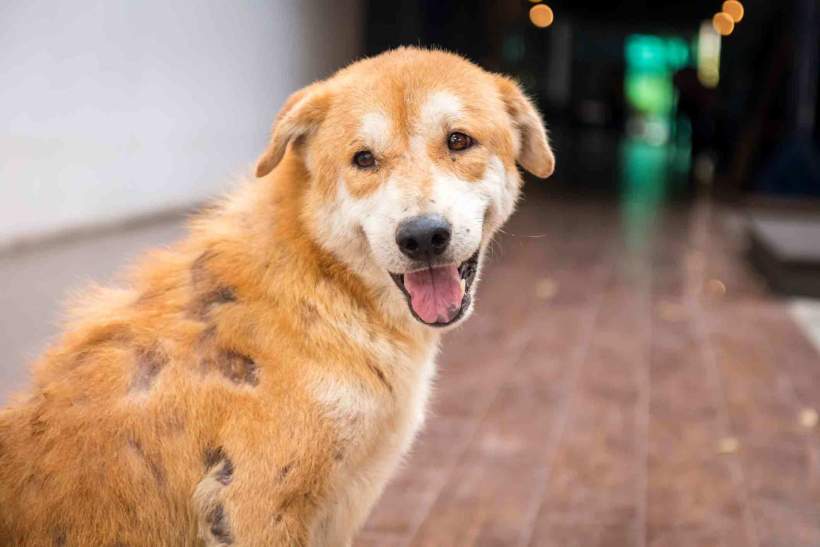
Dogs with thin coats or lightly colored hair like Greyhounds or Chihuahuas are more prone to damaged skin due to sun rays.
Skin cancer is the most often diagnosed canine cancer, considering lumps are easier to recognize. Detecting any issue early and verifying that it is skin cancer will increase the probability of your dog recovering.
Most Common Causes in Dogs
Skin cancer can have several causes. Same as humans, genetics play a massive part in dogs’ susceptibility to skin cancer. While genetics is a vital component of skin cancer, there are other triggers such as exposure to harmful UV rays, chemicals in the environment, and various types of viruses.
You’re likely to be anxious regarding cancer if you have noticed a growth or some skin patches on your pup. Nevertheless, it’s necessary to note that not all growths and lumps are cancerous, and for those that are malignant, several are subject to cure if recognized early.
Most bumps and lumps that you spot on your furry friend will not be as grave as cancer. According to NC State Veterinary Hospital, between 60% to 80% of skin tumors in dogs are benign, which means if you see growths on your dog’s skin, there’s a safe bet it won’t be something to be afraid of.
But, it’s still a must to visit the vet if you do notice anything peculiar on your dog’s skin. Bear in mind that it’s always best to be safe than sorry with regards to your dog’s well-being. Early discovery and cure are the cues to solid treatment results.
Types
Cancer is caused by the uncontrolled growth of cells in the body, which scatter across other body parts. These cells may later develop into tumors, which can be benign (not cancerous) or malignant (cancerous).
Like humans who can have various types of skin cancer, there are also several dog skin cancers. Cancerous cells can grow and attach themselves to lymphatic or circulatory systems if not seen and prevented. It can also expand and affect other tissues in the body.
Squamous Cell Carcinoma
Squamous Cell Carcinoma is the most prevalent type of skin cancer in canines. These usually emerge as a white skin mass or a raised bump on the skin. It typically results from a heterogeneous combination of risk factors; some are genetics, while some are environmental.
They are generally seen on the dog’s head, belly, lower limbs, and rectum. Exposure to the sun is likewise a determining factor in the growth of these tumors, plus the papillomavirus has also been associated with skin cancer.
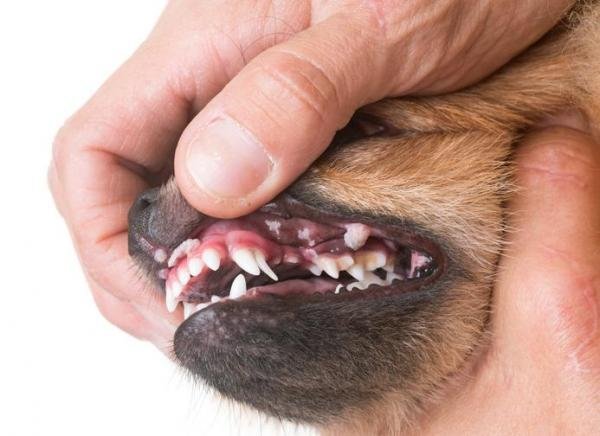
Some pups suffer from various cutaneous squamous cell carcinoma tumors. These tumors occasionally affect the lungs and local lymph nodes. These can be complex problems to control and may need medical assistance with topical or oral medications.
Canines prone to have Squamous Cell Carcinoma are short-haired and light-colored hair dogs such as Beagles, Bull Terriers, Dalmatians, and Standard Schnauzers. Additionally, giant dogs with dark-colored hair tend to have this cancer on their toes, like Rottweilers and Labrador Retrievers. This type of skin cancer is likely to develop in dogs aged six to ten.
Mast Cell Tumor
A mast cell is a type of white blood cell observed in several body tissues, usually associated with allergic reactions. Mast cell tumors appear in the immune system’s mast cells and are highly prevalent in dogs. They produce allergic signs by releasing mediators upon cell stimulation.

They are the most frequent skin tumor in canines, representing approximately 20% of all stated skin tumors. Mast cell tumors can be highly aggressive and usually redevelop after surgery; they may also spread. Some gene mutations are perceived to be connected to the growth of MCTs.
This type of cancer is usually diagnosed in dogs aged between eight and ten. Mast cell tumors are typically observed in Pugs, Boxers, Labrador Retrievers, Boston Terriers, and Beagles.
Malignant Melanoma
Malignant melanoma is caused by melanocytes or pigmented cells in the body. This type of dog skin cancer can be invasive and a severe threat to your pet’s well-being. It can also spread rapidly and is more prone to spread across other organs.
Exposure to harmful UV rays is the common cause of melanoma in people. Though, the connection between melanoma in dogs and the sun’s rays remains uncertain. It can occur in the mouth (mainly on the palate, gums, and lips), on the foot, body parts with hair, and sometimes in the eye.
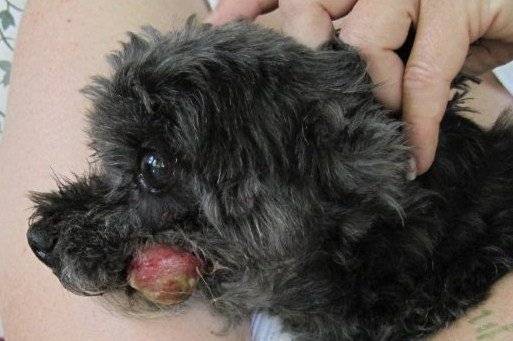
Melanomas may look like dark-pigmented, raised lumps. Older dogs are particularly at high risk of this cancer, and males are more at risk than females. And Scottish Terriers and Schnauzers are at a heightened risk.
Histiocytic Cell Tumors
This type of skin cancer is somewhat prevalent and usually prone to pups aged three years and below. These include Chinese Shar-Pei, Boston Terriers, Boxers, Greyhounds, Bulldogs, and Scottish Terriers.
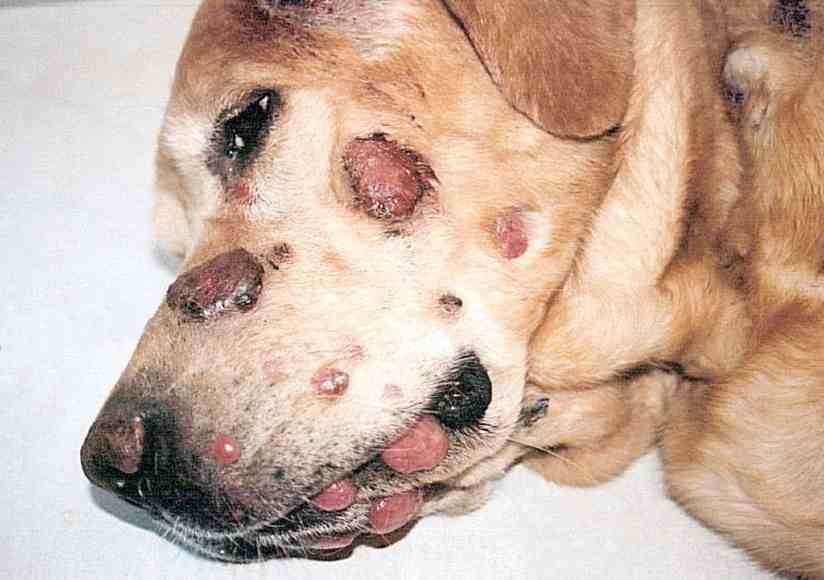
Fibrosarcoma
A fibrosarcoma is a malignant tumor that originates from the uncontrolled growth of fibroblasts cells. This type of skin cancer develops in the skin’s connective tissues and underneath the skin.
Fibrosarcoma is usually seen on the legs and typically affects middle-aged to older dogs. Normally stagnant, this skin cancer infrequently spreads but can ulcerate, bleed and get infected.
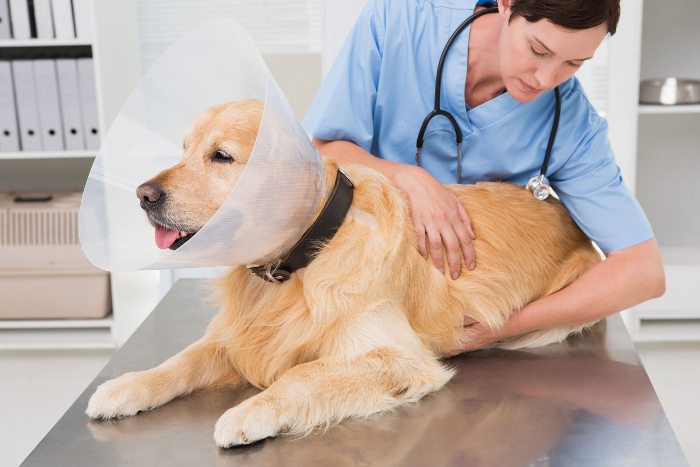
Symptoms
Various symptoms will manifest depending on the type of cancer. Usually, as your dog matures, you need to observe the skin for unusual bumps and lumps thoroughly. Keep an eye for these symptoms:
- Wart-like nodes (2mm-1cm)
- May emerge anywhere, though often observed on the head, face, or eyelids
- Yellow, brown, or black in color
- Bleeding and ulceration
- Shedding of hair around the lumps
- Soreness and redness
- Swelling and inflammation
Watch out for wounds or other bruises that are typically associated with cancer. In most cases, they can be confused as mere infections.
Dog Skin Lesions Cancer
This is can be characterized by an irregular swelling, shape, and color which differs from the rest of your dog’s skin. It may manifest on several of your dog’s body parts and may cover a small or huge spot. Skin lesions include hardening, bumps, discolorations, inflammation, blicks, pus-filled sacs, cysts, rashes, or any changes in their skin.
Skin lesions may be due to numerous causes, as mild as a bit of scratch or as severe as skin cancer.
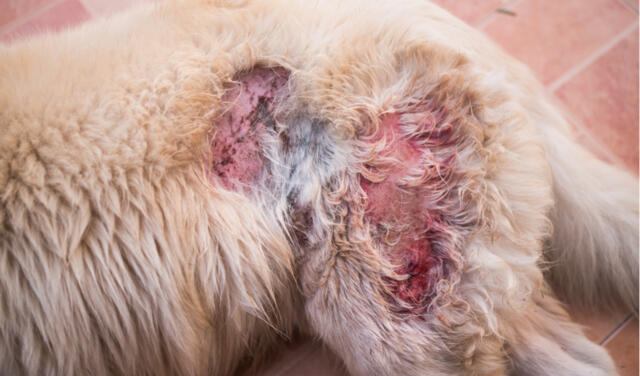
The typical causes of skin lesions are folliculitis, minor skin infections, allergies, contagious illnesses, aging, and abrasion. Incurable diseases like autoimmune diseases or diabetes can also lead to skin lesions. Skin cancer or precancerous developments likewise emerge as skin lesions.
Dog Skin Cancer Lump
For many pet parents, a lump on your dog can be a cause of fear and concern. Most people tend to link lumps on dogs with cancer. But it’s necessary to note that various types of lumps can occur on your dog for a bunch of reasons, like genetics.
Your vet will wish to know:
- Whether the lump emerged out of the blue
- If the size, form, or color has changed
- If the dog’s behaviors are unusual, like their level of energy and appetite
Some canines like Boston Terriers and Boxers face a higher risk of tumors that develop on the surface.
- Benign Tumors – Benign tumors are not aggressive lumps and can be treated via surgical removal. It does not penetrate adjacent tissue or expand to several body parts. Common benign tumors are fatty tumors, cysts, lipomas, and warts. Though some types of benign tumors can develop into malignant tumors, thus requires strict observation.
- Malignant tumors are uncontrolled growth cells that are cancerous since they attack and spread in other tissues. Include a wide variety of masses, including lymphoma, mast cell tumors, and squamous cell carcinomas. A comprehensive health checkup with diagnostic examination is a must to determine the type of tumor present.
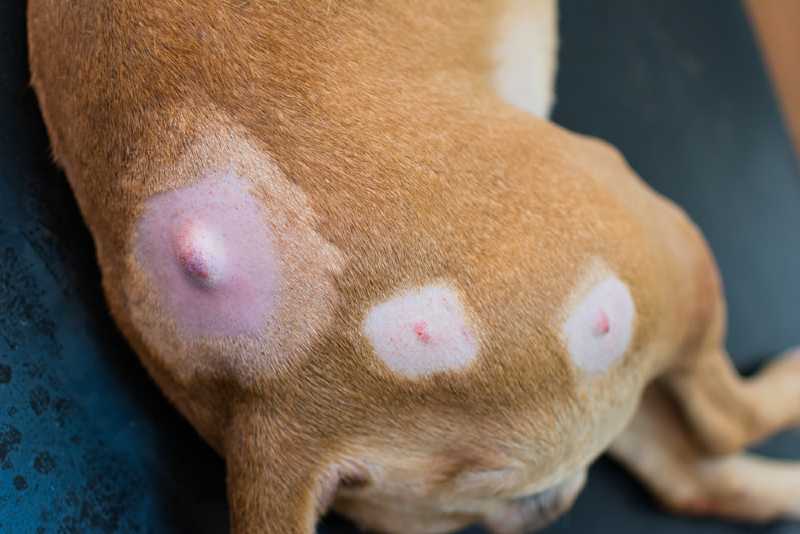
Your vet can perhaps determine from the microscope if the tumor is only benign or whether it has plenty of suspicious cells to need further testing with a more thorough pathology review, a biopsy, or removal. Among the most reliable methods to recognize a possible malignant mass is to assess the lump through touching.
A malignant lump will be harder and stiffer to the touch, as opposed to the soft, plump aspects of a benign, looking to be as a solid, rooted lump on your dog.
A bump on a dog’s face or neck may likewise induce smelly secretion from the eyes, snout, or mouth, and this odor can be another sign that the lump is malignant. In the end, it’s hard to identify if a lump is malignant by a mere touch or physical exam. Even your vet will perhaps require carrying out a biopsy to conclude if the lump is cancerous or not.
As far as growths or lumps on your dog go, don’t play the waiting game. Benign lumps may grow too big to be removed without difficulty. If the lump is malignant, then early discovery is essential for finding the appropriate treatment and remedy.
Treatment
Diagnosing Skin Cancer in Dogs
Your vet may recommend X-rays, blood samples, and blood analyses to assist them in having a precise diagnosis.
Suppose the vet thinks that your dog suffers from skin cancer; he may conduct a biopsy. It enables him to obtain a part of the lump’s tissue, which will be analyzed. The specimens obtained by the vet will be given to a lab for examination to provide a specific judgment on your dog’s health.
Your vet may suggest further diagnostic trials if the dog is positive for skin cancer better to deduce the scope of your pup’s cancer. Plus, to heighten medication and equip you with more detailed foresight.
Treatment for Skin Cancer in Dogs
The typical treatment plan is surgery as soon as the vet has analyzed the mass and genetics. Most skin cancers are benign. Most non-malignant dog skin cancers can be managed favorably, letting dogs continue having homely, peaceful lives for the coming years.
A surgical procedure, chemotherapy, radiation therapy, and other sorts of treatments and medications may be options. This will depend on several factors, such as the type of tumor, position, and the progression or stage of cancer, along with your dog’s age and overall health status.
With benign skin cancer, the chance of redevelopment is low, provided that the tumor has been completely removed. Skin cancers are prone to grow on several parts of the skin, so your dog may need potential lumps removed as well.
Dogs Skin Cancer Care
Recognizing the symptoms of skin cancer in the initial stages will improve the chances of success. If you see an unfamiliar or strange mass or growth on your dog, or if you spot any inflammation around your pet’s digits, talk to your vet immediately.
Preventing Pet Skin Cancer
You can’t stop cancers from happening, though you can be hands-on regarding the health of your dog.
- Adhere to your pet’s yearly health check-up – To identify skin cancer at an early stage, you need to bring your dog to the vet regularly. Even the most invasive type of cancers are a lot easier to manage if detected early.
- Your vet must assess bumps and growths on your furry friend without delay. Your vet will probably come up with a diagnosis by conducting prompt cytology or needle biopsy.
- Limit your dog’s exposure to the sun, particularly if it has a white or thin coat. When spending time outdoors, provide a shaded space for canines all the time, particularly during the hottest times of the day.
- Refrain from hot surfaces such as sand, cement, and asphalt, or have your pet wear a pair of protective shoes.
- Suppose your pet companion has short fur, either from birth because of its genealogy or due to its haircut; you must use sunscreen to safeguard against damaging rays. Use sunscreens or consult your vet for a recommendation. Make sure to refrain from products with zinc oxide since it is toxic for your pet.
- Establish regular grooming to monitor the skin and overall general health – Vigorous skincare for dogs begins at your home with regular grooming sessions.
- Brush your dog as frequently as possible to eliminate mats and rubble. You should also examine your dog’s skin for lumps, rashes, and dry skin.
- Part the hair and be on the lookout for redness, scabs, dirt, flea bites, or sections where your dog may be shedding hair. Bathe your pet with mild and moisturizing shampoos. A helpful guideline is that you must bathe your dog monthly.
- Be Careful of Spaying – If your family companion is a breed recognized to possess an increased rate of skin cancer, speak with your vet before neutering or spaying. Modern research has attested that neutering your dog raises the odds of some cancers. But, the advantages of neutering/spaying – reducing wanderlust, inhibiting undesired litter, and lessening aggression – usually outweigh the possible prices, eventually.
- As a pet parent, the most crucial thing you can do is proceed with your vet if anything appears different. Monitoring your pet’s well-being can have substantial benefits in detecting and early recovery of its condition.
- After some time, maintaining a balanced diet, granting ample exercise, and maintaining a fit body frame are the most suitable ways to optimize your dog’s possibilities to avoid catching skin cancer.